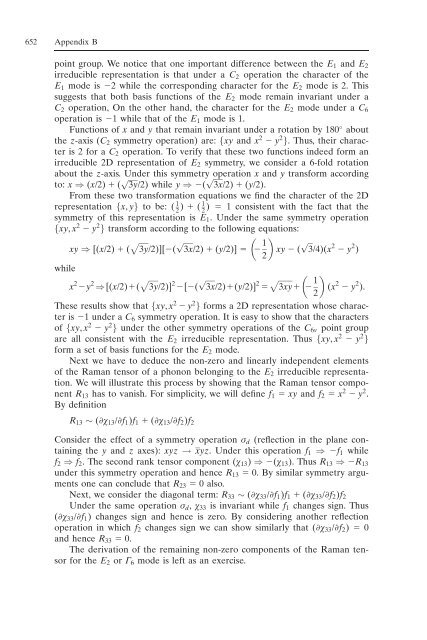10. Appendix
You also want an ePaper? Increase the reach of your titles
YUMPU automatically turns print PDFs into web optimized ePapers that Google loves.
652 <strong>Appendix</strong> B<br />
point group. We notice that one important difference between the E1 and E2<br />
irreducible representation is that under a C2 operation the character of the<br />
E1 mode is 2 while the corresponding character for the E2 mode is 2. This<br />
suggests that both basis functions of the E2 mode remain invariant under a<br />
C2 operation, On the other hand, the character for the E2 mode under a C6<br />
operation is 1 while that of the E1 mode is 1.<br />
Functions of x and y that remain invariant under a rotation by 180◦ about<br />
the z-axis (C2 symmetry operation) are: {xy and x2 y2 }. Thus, their character<br />
is 2 for a C2 operation. To verify that these two functions indeed form an<br />
irreducible 2D representation of E2 symmetry, we consider a 6-fold rotation<br />
about the z-axis. Under this symmetry operation x and y transform according<br />
to: x ⇒ (x/2) ( √ 3y/2) while y ⇒ ( √ 3x/2) (y/2).<br />
From these two transformation equations we find the character of the 2D<br />
representation {x, y} to be: ( 1 1<br />
2 ) ( 2 ) 1 consistent with the fact that the<br />
symmetry of this representation is E1. Under the same symmetry operation<br />
{xy, x 2 y 2 } transform according to the following equations:<br />
xy ⇒ [(x/2) ( 3y/2)][( √ 3x/2) (y/2)] <br />
<br />
1<br />
2<br />
<br />
xy ( √ 3/4)(x 2 y 2 )<br />
while<br />
x 2 y 2 ⇒[(x/2)( 3y/2)] 2 [( √ 3x/2)(y/2)] 2 <br />
3xy 1<br />
<br />
(x<br />
2<br />
2 y 2 ).<br />
These results show that {xy, x2 y2 } forms a 2D representation whose character<br />
is 1 under a C6 symmetry operation. It is easy to show that the characters<br />
of {xy, x2 y2 } under the other symmetry operations of the C6v point group<br />
are all consistent with the E2 irreducible representation. Thus {xy, x2 y2 }<br />
form a set of basis functions for the E2 mode.<br />
Next we have to deduce the non-zero and linearly independent elements<br />
of the Raman tensor of a phonon belonging to the E2 irreducible representation.<br />
We will illustrate this process by showing that the Raman tensor component<br />
R13 has to vanish. For simplicity, we will define f1 xy and f2 x2 y2 .<br />
By definition<br />
R13 ∼ (¯13/f1)f1 (¯13/f2)f2<br />
Consider the effect of a symmetry operation Ûd (reflection in the plane containing<br />
the y and z axes): xyz → xyz. Under this operation f1 ⇒ f1 while<br />
f2 ⇒ f2. The second rank tensor component (¯13) ⇒ (¯13). Thus R13 ⇒ R13<br />
under this symmetry operation and hence R13 0. By similar symmetry arguments<br />
one can conclude that R23 0 also.<br />
Next, we consider the diagonal term: R33 ∼ (¯33/f1)f1 (¯33/f2)f2<br />
Under the same operation Ûd, ¯33 is invariant while f1 changes sign. Thus<br />
(¯33/f1) changes sign and hence is zero. By considering another reflection<br />
operation in which f2 changes sign we can show similarly that (¯33/f2) 0<br />
and hence R33 0.<br />
The derivation of the remaining non-zero components of the Raman tensor<br />
for the E2 or °6 mode is left as an exercise.










